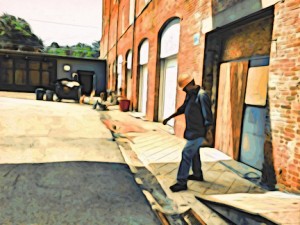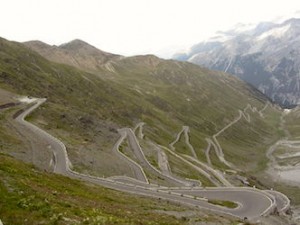I know I’ve kinda built up the idea about myself that I don’t care about medieval warfare, that I consider it an absurd waste of thought. And, well, generally speaking, you’d be right. I think it’s a distraction from the things that actually matter, like actual historical construction methods. I’m interested in how they put things together, not how they broke them.
That being said, some slightly interesting uses were found for ramps in war, specifically for the purposes of siegecraft.
 The first use was actually pre-medieval, though it was used on occasion in medieval times. Siege ramps are huge earthen ramps built right up a castle or city wall, a cliff face, or other positions of strength. They’re about as absurd as you’d think: the builders are going to come under constant attack by the people above, resulting in a wasteful loss of life. It was really only used when the besiegers grossly outnumbered the besieged, were otherwise unable to break through the enemy defenses, and had little care for loss of life on their side. The Romans used it a few times, as did a few of the smaller empires before them, and a few of the smaller kingdoms they conquered.
The first use was actually pre-medieval, though it was used on occasion in medieval times. Siege ramps are huge earthen ramps built right up a castle or city wall, a cliff face, or other positions of strength. They’re about as absurd as you’d think: the builders are going to come under constant attack by the people above, resulting in a wasteful loss of life. It was really only used when the besiegers grossly outnumbered the besieged, were otherwise unable to break through the enemy defenses, and had little care for loss of life on their side. The Romans used it a few times, as did a few of the smaller empires before them, and a few of the smaller kingdoms they conquered.
 The other use was in siege towers. These, at least, were constructed with a bit more safety in mind for the troops on your side: not that sending them over an enemy castle wall is, particularly, a safer idea. Siege towers, depending on the whim of the builder, were generally a bizarre hybrid of ramp, staircase, ladder, and watchtower, all built out of wood and canvas and stuck on wheels to roll right up to the castle walls, where troops could exit the tower directly onto those walls.
The other use was in siege towers. These, at least, were constructed with a bit more safety in mind for the troops on your side: not that sending them over an enemy castle wall is, particularly, a safer idea. Siege towers, depending on the whim of the builder, were generally a bizarre hybrid of ramp, staircase, ladder, and watchtower, all built out of wood and canvas and stuck on wheels to roll right up to the castle walls, where troops could exit the tower directly onto those walls.
They also usually had sheltered positions for archers to fire from. Still absurdly dangerous, of course, but you at least had some shelter from enemy arrows, at least until you got onto the wall. They still were vulnerable to fire, which medieval people loved to use on each other.
All in all: I prefer my ramps for actual construction purposes.
 The ancient Greeks recognized three simple machines to start with: the lever, the screw, and the pulley. The man who came up with the idea, Archimedes, was a brilliant but crazy guy. Built crazy ancient super weapons to sink entire enemy fleets one day, then jury rigged an ancient precursor to calculus the next. He’s considered one of the greatest mathematicians of all time for a good reason. He’s the kind of dude who could have moved the world, if you gave him a long-enough lever.
The ancient Greeks recognized three simple machines to start with: the lever, the screw, and the pulley. The man who came up with the idea, Archimedes, was a brilliant but crazy guy. Built crazy ancient super weapons to sink entire enemy fleets one day, then jury rigged an ancient precursor to calculus the next. He’s considered one of the greatest mathematicians of all time for a good reason. He’s the kind of dude who could have moved the world, if you gave him a long-enough lever. After Simon Steven completed the simple machine sextet, of course, the development of the science behind simple machines hardly stopped. Galileo Galilei, notably, was the first to figure out that they didn’t create energy but merely transformed it. Leonardo da Vinci also made some critical discoveries regarding calculating friction in simple machines; then he promptly left them unpublished in his notebooks. It took almost two hundred years for someone else to independently rediscover them.
After Simon Steven completed the simple machine sextet, of course, the development of the science behind simple machines hardly stopped. Galileo Galilei, notably, was the first to figure out that they didn’t create energy but merely transformed it. Leonardo da Vinci also made some critical discoveries regarding calculating friction in simple machines; then he promptly left them unpublished in his notebooks. It took almost two hundred years for someone else to independently rediscover them. A simple machine is a device used to change the direction or power of a force applied to something in the simplest manner possible. There are six devices classically categorized as simple machines: axles and wheels, levers, pulleys, screws, wedges, and inclined planes (obviously the best).
A simple machine is a device used to change the direction or power of a force applied to something in the simplest manner possible. There are six devices classically categorized as simple machines: axles and wheels, levers, pulleys, screws, wedges, and inclined planes (obviously the best). Terraces might be something of an opposite of ramps, but that just makes them more fascinating. Living among some of the steepest mountains in the world, the Incans had to improvise heavily when it came to all sorts of facets of their life. Their terraces did a lot more than provide flat areas for food production (though don’t get me wrong: that was just a little bit important); they also helped to control erosion and landslides.
Terraces might be something of an opposite of ramps, but that just makes them more fascinating. Living among some of the steepest mountains in the world, the Incans had to improvise heavily when it came to all sorts of facets of their life. Their terraces did a lot more than provide flat areas for food production (though don’t get me wrong: that was just a little bit important); they also helped to control erosion and landslides. The most famous are almost certainly the rice terraces of the Philippine Cordilleras: they’ve actually been declared a UNESCO heritage site. You’ve almost certainly seen images of them before. They’ve been farmed continuously for something like 2000 years, which is absolutely crazy. That’s not just architecture, it’s a way of life.
The most famous are almost certainly the rice terraces of the Philippine Cordilleras: they’ve actually been declared a UNESCO heritage site. You’ve almost certainly seen images of them before. They’ve been farmed continuously for something like 2000 years, which is absolutely crazy. That’s not just architecture, it’s a way of life. One of the craziest examples of the breed is the
One of the craziest examples of the breed is the